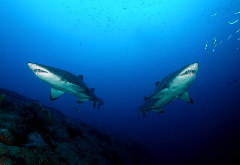
By Dave Harasti (Published in Australasia Scuba Diver 2007: Issue 1)
“It’s just another Wednesday afternoon as I’m in the process of finishing up a days work when the phone rings. “Dave, you have to get up here tomorrow, Fish Rock is going off and there are sharks everywhere.” The phone hangs up and I ponder; is it worth taking a sickie tomorrow and driving four hours up the New South Wales coast just to photograph some sharks? Peter Hitchins, co-owner of South West Rocks Dive Centre, was very excited when he called me and did state that the ‘rock was going off’ and he’s not normally one to exaggerate.
The alarm goes off at 3am the next morning; it’s raining outside and the last thing I want to do is drive 4 hours up the coast for just for a dive. But what the heck, it could be worth it. 6 hours later and the boat pulls up to the moorings at Fish Rock on a perfect millpond sea. I look into the clear blue water and can see the bottom in 30 metres…it looks like this drive was worth it!
Descending down the mooring line with camera in tow I look over into the shark gutter…and there they are lined up like sleeping logs suspended just above the ocean floor. 10, 20, no, there at least 30 sharks all hovering in the one gutter and there are probably many more in the other gutters around the rock. I ascend an hour later absolutely stoked that I’ve been fortunate enough to diver with 50 or so grey nurse sharks on a single dive.”
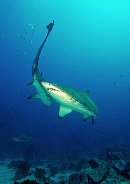 The Grey Nurse Shark (Carcharias taurus) is one of the most endangered marine species in Australia. This species of shark is found worldwide and is known in the United States as the sand tiger shark and in South Africa as the spotted ragged-tooth shark. The species is protected in the United States however in South Africa there is a recreational bag limit of 5 per person per day! In Australia, the grey nurse is under threat and the east coast population is listed as 'critically endangered' by the Australian Government meaning that there is a possibility that the species may become locally extinct.
The Grey Nurse Shark (Carcharias taurus) is one of the most endangered marine species in Australia. This species of shark is found worldwide and is known in the United States as the sand tiger shark and in South Africa as the spotted ragged-tooth shark. The species is protected in the United States however in South Africa there is a recreational bag limit of 5 per person per day! In Australia, the grey nurse is under threat and the east coast population is listed as 'critically endangered' by the Australian Government meaning that there is a possibility that the species may become locally extinct.
The grey nurse shark has a mouthful of long pointy teeth that gives it a rather ferocious look that led to it being labelled a century ago as a man-eater. Fortunately we now know better as this species is quite harmless and divers and the general community no longer consider the grey nurse shark a dangerous species. Many previous sharks attacks were wrongly attributed to the grey nurse shark and it is now a very popular shark with aquariums due to its fierce looks, big pointy teeth and ability to survive well in captivity. The shark is considered to be an iconic species in NSW and QLD and divers are very passionate about the protection of this much loved species. I liken the grey nurse to a Labrador puppy dog; they are a very curious species and I refer to them as the ‘Labradors of the Sea’.
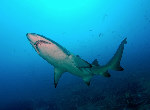 In the past, the grey nurse shark had an undeserved reputation in Australia as a man-eater which led to indiscriminate killing of the species by spear and line fishers from the 1950s to 1970s. The mass slaughter of thousands of grey nurse sharks led to a dramatic decline in the numbers along the east coast of Australia. Divers and spearfishers reacted to this decline by voicing their concerns to all that would listen and the NSW Government protected the shark in 1984, making it the first shark to be protected in the world. However, the east coast population has not recovered since its protection in 1984 and there are concerns that the numbers are still declining pushing it towards extinction.
In the past, the grey nurse shark had an undeserved reputation in Australia as a man-eater which led to indiscriminate killing of the species by spear and line fishers from the 1950s to 1970s. The mass slaughter of thousands of grey nurse sharks led to a dramatic decline in the numbers along the east coast of Australia. Divers and spearfishers reacted to this decline by voicing their concerns to all that would listen and the NSW Government protected the shark in 1984, making it the first shark to be protected in the world. However, the east coast population has not recovered since its protection in 1984 and there are concerns that the numbers are still declining pushing it towards extinction.
 One of the major contributing factors to the species decline is its unusual reproductive biology. Grey nurses reach sexual maturity at approximately 4-6 years for males and 6-8 years for females. They are an ovoviviparous species, meaning that they give birth to pups after they have hatched from eggs within the uterus. This is where the reproductive system gets interesting. Up to 15 embryos start developing in each of the two uteri and the two most advanced embryos in each uterus then eat all the other developing embryos and unfertilised eggs. This phenomenon is known as inter-uterine cannibalism. So they have basically eaten all their brothers and sisters before they are born!
One of the major contributing factors to the species decline is its unusual reproductive biology. Grey nurses reach sexual maturity at approximately 4-6 years for males and 6-8 years for females. They are an ovoviviparous species, meaning that they give birth to pups after they have hatched from eggs within the uterus. This is where the reproductive system gets interesting. Up to 15 embryos start developing in each of the two uteri and the two most advanced embryos in each uterus then eat all the other developing embryos and unfertilised eggs. This phenomenon is known as inter-uterine cannibalism. So they have basically eaten all their brothers and sisters before they are born!
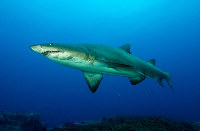 The gestation period is also very long, lasting 9-12 months and the two pups are born at about 80cm to 100cm in length. Females only reproduce every 2nd year, therefore on average only 1 pup per female is produced per year. The maximum size for the species is believed to be about 3.5 metres and it estimated they grow up to 25 years old in the wild. They are considered a harmless shark and are not a threat to humans unless they are provoked.
The gestation period is also very long, lasting 9-12 months and the two pups are born at about 80cm to 100cm in length. Females only reproduce every 2nd year, therefore on average only 1 pup per female is produced per year. The maximum size for the species is believed to be about 3.5 metres and it estimated they grow up to 25 years old in the wild. They are considered a harmless shark and are not a threat to humans unless they are provoked.
The range of the east coast population is believed to extend from Wolf Rock in Queensland down to Montague Island in NSW. Research on the grey nurse sharks in Australia has found that they migrate north - south at certain times of the year. It is believed that their migration is in relation to changing water temperatures, as they are generally found in water temps from 18 - 24 degrees celsius, and that they are also found following prey species such as the jewfish and mullet.
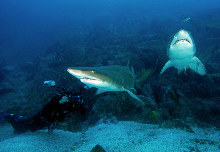 A new project is being implemented by Ms Carley Bansemer as part of her PhD research through the University of Queensland. Carley is studying the distribution and abundance of grey nurse sharks in Queensland waters and as part of the project individual sharks are being photographed and with their unique spot markings they can be individually recognised. “The concept of using photo’s for identification removes the process of having to tag the shark which can be costly and more time consuming” Ms Bansemer said. To date approximately 300 sharks have been identified from photographs taken along the east coast of Australia. A photographic database has been established so that divers can send photo’s into Carley so that she can keep track of individual movements of sharks. This project will provide useful information that can be used to assist in the conservation of the grey nurse in Queensland waters. During the months of February and July 2007, Carley is coordinating grey nurse shark surveys and she is always looking forward to receiving new grey nurse shark photos for ID purposes. Those divers that are interested in assisting Carley with this research project can contact her via email on s3339916@student.uq.edu.au.
A new project is being implemented by Ms Carley Bansemer as part of her PhD research through the University of Queensland. Carley is studying the distribution and abundance of grey nurse sharks in Queensland waters and as part of the project individual sharks are being photographed and with their unique spot markings they can be individually recognised. “The concept of using photo’s for identification removes the process of having to tag the shark which can be costly and more time consuming” Ms Bansemer said. To date approximately 300 sharks have been identified from photographs taken along the east coast of Australia. A photographic database has been established so that divers can send photo’s into Carley so that she can keep track of individual movements of sharks. This project will provide useful information that can be used to assist in the conservation of the grey nurse in Queensland waters. During the months of February and July 2007, Carley is coordinating grey nurse shark surveys and she is always looking forward to receiving new grey nurse shark photos for ID purposes. Those divers that are interested in assisting Carley with this research project can contact her via email on s3339916@student.uq.edu.au.
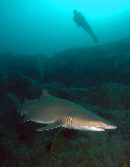
 I have been fortunate enough to dive the majority of the grey nurse shark aggregation areas along the east Australian coast and I have several favourite locations where you can view these 'puppy dogs'. In Queensland the best spot is a site called Wolf Rock located off Rainbow Beach. At Wolf Rock it appears that there is a resident pack of females that are present all year round and the males come in over the summer months to mate. They can also be seen at Flat Rock off Moreton Bay in the winter months.
I have been fortunate enough to dive the majority of the grey nurse shark aggregation areas along the east Australian coast and I have several favourite locations where you can view these 'puppy dogs'. In Queensland the best spot is a site called Wolf Rock located off Rainbow Beach. At Wolf Rock it appears that there is a resident pack of females that are present all year round and the males come in over the summer months to mate. They can also be seen at Flat Rock off Moreton Bay in the winter months.
In New South Wales, there are many locations to choose from, including the ten sites that the NSW Government has listed as critical habitat. Of these sites, my favourite spot to dive with the sharks is definitely at Fish Rock located off South West Rocks on the NSW north coast. At Fish Rock, large numbers of big males and females can be observed during winter and I have been fortunate to witness on two separate occasion's sharks attempting to mate in the shark gutter. Another good spot to view some big grey nurse sharks (larger than 3 metres) is at Big and Little Seal Rocks off Seal Rocks on the NSW mid north coast.
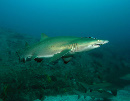 An excellent location to photograph the grey nurse is at the Tollgate Islands on the NSW south coast over the January to April period. Up to 30 sharks can be found in a gutter that is only 10 metres deep and with a good days' visibility wide angle shots with natural light can be taken. This is my favourite spot to shoot the sharks as bottom times are longer due to the shallow depth and the sharks are very curious at this location and will swim straight up to you. Another good location for photography is the Looking Glass at Broughton Island just out from Port Stephens as it generally has nice clear water and sharks can be photographed swimming in amongst massive schools of fish in a big cave system. There is even a site located on Sydney's doorstep, Magic Point that is conveniently located just around the corner from the famous Bondi beach!
An excellent location to photograph the grey nurse is at the Tollgate Islands on the NSW south coast over the January to April period. Up to 30 sharks can be found in a gutter that is only 10 metres deep and with a good days' visibility wide angle shots with natural light can be taken. This is my favourite spot to shoot the sharks as bottom times are longer due to the shallow depth and the sharks are very curious at this location and will swim straight up to you. Another good location for photography is the Looking Glass at Broughton Island just out from Port Stephens as it generally has nice clear water and sharks can be photographed swimming in amongst massive schools of fish in a big cave system. There is even a site located on Sydney's doorstep, Magic Point that is conveniently located just around the corner from the famous Bondi beach!
So if you ever get a chance to visit Australia, try to visit one of these grey nurse shark locations for a dive with this endangered species. It is easily one of the best shark encounters you can ever have…
Additional Photos of Grey Nurse Sharks